
It’s safe to say, the role of an internal comms professional can be a wee bit chaotic.
We rub shoulders with senior leaders to articulate organisational vision, mission and values.
Transform organisational messages into stories that spark action and engagement.
Work with managers to cascade communications down through the business and back up again.
Regularly check in with the bottom line to gauge levels of engagement across the workplace.
All while weaving constant wordsmith wizardry and having to prove that the internal communications game truly is worth the candle.
Phew – we’re worn out just thinking about it!
And the list doesn’t stop there. Last year, we asked 12 internal communications professionals exactly what their day-to-day entails – and one of our respondents revealed that they often juggle more than 50 different internal communications projects simultaneously in their workplace.
With so much to think about, it’s possible that internal comms best practices may slip under the radar.
Why are internal comms best practices critical to communication success in the workplace?
We know internal communicators often feel like they’re moving mountains.
Many of our clients have come to us for help with implementing high-complexity communications initiatives and intricate long-term engagement programmes, often against the clock.
But when you’re facing the frantic daily firefighting, in order to turn all the grand visions and extensive, elaborate initiatives into exceptional results – it’s vital to always keep sight of fundamental internal communications best practices in the workplace.
This is absolutely key to achieving success.
So in the spirit of getting back to basics, we’ve hand-picked 7 essential internal comms best practices that internal communicators need to keep front-and-centre – as well as giving you the scoop on some of our best internal communications examples from projects we’ve delivered for our clients – to help you create workplace comms that make a lasting and powerful impact.
Before we dive in, did you know you could be receiving an exciting dollop of internal comms inspiration every week?
Subscribe to our Friday Ketchup to get handpicked internal comms and employee engagement insights, facts, and ideas squeezed straight into your inbox, every Friday.
7 internal communications best practices for communications greatness
1. Strategize
As strategic internal comms experts, we can’t overstate how important it is to spend time planning internal communications programmes before running away giddy with them.
The strategy is the meat and potatoes of your internal comms plan – a guiding light to help keep you on the right track.
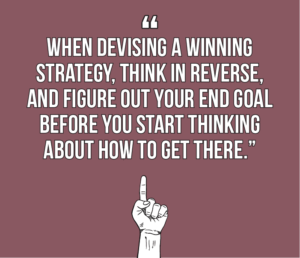
Having a clear, robust, well-considered strategy for your internal communications can make it significantly easier to focus your efforts and have the greatest impact where it’s most needed.
What it’s about is – communicating the right messages, to the right people, in the right way.
When devising a winning strategy, it’s best to think in reverse, and figure out your end goal before you start thinking about how to get there.
What does success look like for you? What are your goals? This goal can be as broad or as specific as you like (for individual campaigns, it’s likely to be much more focused).
When you have sight of where you want to be and what you want to achieve, it’s time to consider the best route to get there.
Key things to take into account are – what messages will help you accomplish your goal? Who will you be communicating them to? Which channels will be the most appropriate and impactful?
Your internal comms strategy can be as lengthy and detailed as you like – but be careful not to go overboard.
Once you have it in full, you may find it helpful to create a summary ‘plan on a page’, highlighting your key tactics so you can easily refer back.
As a bonus, this may also prove handy in getting buy-in from above.
A good example would be this ‘big picture’ strategic-narrative map we put together for the folks over at the Smile Foundation, to help them bring to life the story behind their fun, exciting brand:
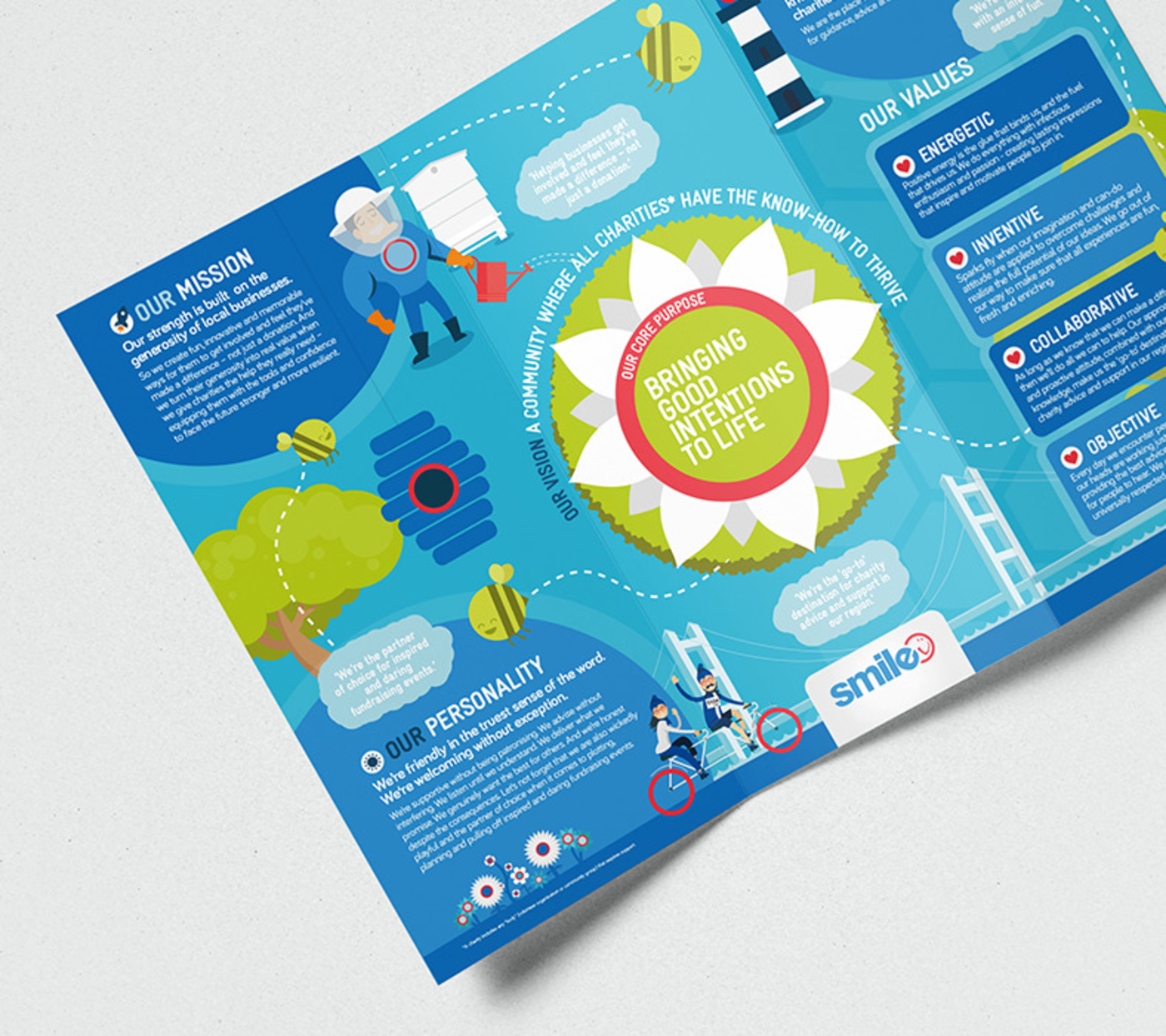
We’re proud to say it went down a treat!
“Just wanted to say another big thank you on the Smile rebrand and to show you and your team what great developments it’s helping us with. We have a very bright future and a great story to communicate.”
– Andy Barber, Smile Director – HEY Smile Foundation
 Got an awesome new business plan you can’t wait to tell your people about? We can help!
Got an awesome new business plan you can’t wait to tell your people about? We can help!
Our expert team of IC strategists, consultants and designers can turn your plan into an exciting, inspiring ‘big picture’ strategy that will get everyone buzzing.
2. Be hyper-specific with your audience
Have you ever received a piece of communication – like a marketing email, let’s say – that was totally irrelevant to you, and thought ‘oh wow, I’m super excited to dip into that!’. No, we haven’t either.
A big part of creating a sticky message that resonates with its recipient is making sure it’s fundamentally relevant to them in the first place.
Gone are the days when organisations could solely distribute generic workplace-wide communications and have done with it.
It pays to be personal – and if you want your employees to actually take notice of what you’re telling them, you should make your internal comms hyper-relevant, and be meticulous about the messages you include.
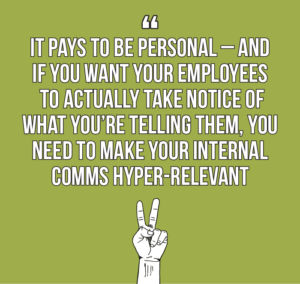
This internal comms best practice is super important.
But there’s also scope to tailor the channels you use as well.
For instance, an employee who sits at a desktop computer all day may prefer to receive messages via email.
Whereas, if you’re trying to reach a remote worker whose only technological companion is their mobile phone, it might be better to use an instant messenger tool like Slack.
Just as marketers devise ‘customer personas’ to help them define specific audiences, you could create ‘employee personas’ to flesh out the audiences on your radar.
This will make it clearer as to how you should segment your communications, and hit the content, style and structure sweet spot for everyone.
One of the easiest ways to find out the information you need to build your employee personas would be to send out a short survey asking questions like, ‘at what time would you prefer to receive communications?’, and, ‘what sorts of information or updates about the business matter most to you?’.
You can create intuitive, speedy polls and surveys with Push – a tool we developed to help internal communications professionals and business leaders get get the answers they need at the ‘push’ of a button.

Get the answers you need to the questions that matter
Create fully customisable polls in minutes and get your finger on the pulse in your organisation with Push. Try it for free today!
3. Align internal comms goals with overarching business goals
As a vital bridge between the C-Suite and the bottom line, internal communicators are uniquely placed to create real value by strategically connecting their own goals with those of the business.
Rallying the troops to deliver organisational objectives, encouraging critical behaviour change, or driving greater workplace performance through enhanced engagement levels.
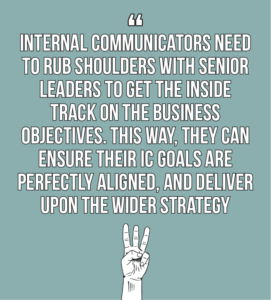
For instance, if a broader business objective is to improve organisational efficiency by improving digital processes, your internal comms goal could be to encourage a change in employees’ ways of working so that they seamlessly and positively adapt.
Or, if a wider goal is to strengthen brand awareness and reputation, you could turn your employees into brand ambassadors by collecting inspiring stories from the bottom line and promoting from the inside out.
A good example of this internal communications best practice in action would be when we worked with not-for-profit organisation Anchor to develop a compelling narrative to help communicate their ambitious growth plan.
It required employees to have a shared understanding of how they could contribute, to enhance performance and encourage the smooth adoption of new ways of working.
And so, our specific internal comms goal became to facilitate this shared understanding.
We created a strategic narrative ‘big picture’ map, and kick-started conversations between managers and their teams to educate employees on how they could help in delivering on the plan.

By aligning the internal comms strategy to the overarching business goal, we empowered Anchor to realise their vision – with a 100% increase in the understanding of the business strategy across the organisation.
This is where internal communicators need to rub shoulders with senior leaders to get the inside track on the business objectives.
This way, you can ensure that your internal comms goals are perfectly aligned, and delivering upon the wider strategy.
 Creating shared understanding across the business
Creating shared understanding across the business
Discover how we created a 100% increase in the number of Anchor employees who were clear on the big-picture strategy by giving our Case Study a gander.
4. Measure, measure, measure
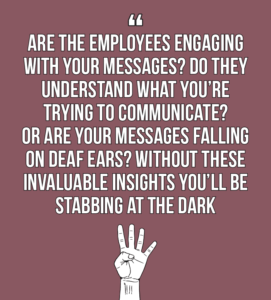 Every internal communicator will be familiar with this old chestnut. But it was revealed this year that 12% of IC practitioners aren’t conducting any measurement at all – twice as many as in 2017!
Every internal communicator will be familiar with this old chestnut. But it was revealed this year that 12% of IC practitioners aren’t conducting any measurement at all – twice as many as in 2017!
Measurement is a best practice that should be at the front of every internal communicator’s mind when planning and cascading internal communications.
It’s vital to ensuring they’re achieving the intended results and resonating throughout the workplace.
Are employees engaging with them, and if so, in what way? Do they understand what you’re trying to communicate? Or are your messages falling on deaf ears?
Without these invaluable insights you’ll be stabbing at the dark, blissfully ignorant to what’s been working, where you need to improve, or whether you need to reconsider your approach.
However, avoid zoning in on output measures at the expense of outcome measures.
Metrics like link clicks, email opens or download numbers are valuable, but they don’t indicate how your employees are responding or feeling.
What you want to know is – did you spark them into action? Did you facilitate behaviour change? Has understanding been increased? Strike a balance between the two to get the juiciest insights out of your measurement activity.
 In internal comms, it pays to be informed
In internal comms, it pays to be informed
Benchmark your own IC and employee engagement results against the industry with our IC Field Guide infographic series, made up of the latest must-know facts and stats.
5. Make the complex, simple
This best practice principle underpins all the internal communications we help our clients create.
When you’ve got a particularly juicy story to tell, or the information you’re communicating is complicated, intricate or expansive, it can be tempting to cram every last detail in to ensure you don’t leave anything important out.
But when you’re reaching out to mass audience, with potentially varying literacy levels – and in the case of employees, not a whole lot of time to devote to interacting with internal communications – the key to making your messages widely accessible and engaging is to communicate as concisely and simply as possible.
When it comes to internal communications best practices in the workplace, less is most certainly more.
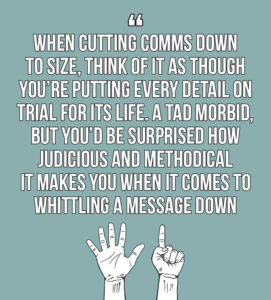 This means extracting the core golden nuggets from your message and prioritising what your audience really needs to know.
This means extracting the core golden nuggets from your message and prioritising what your audience really needs to know.
Think of it as though you’re putting every detail on trial for its life – a bit morbid, but you’d be surprised how judicious and methodical it makes you when it comes to whittling a message down.
It’s also important that if your message is particularly complex or convoluted, you figure out the best way to articulate and reframe it to make it as easy to understand and digest as possible.
For instance, major organisational changes (they’re cropping up a lot, aren’t they?) can be incredibly intricate and complicated. To ensure mass understanding and investment, re-contextualise them into a narrative that’s easy to follow, ingest, and understand – otherwise, you’ll be fighting an uphill struggle to get people to buy in.
Storytelling can come in very handy in this scenario.
Using metaphors is a great way to make a complex idea accessible and relatable. If you’re trying to communicate a complex, complicated business issue, connect it to something universal and paint a vivid picture so the audience can see it through a different, simpler lens.
Which leads us nicely onto…
6. Tell great stories
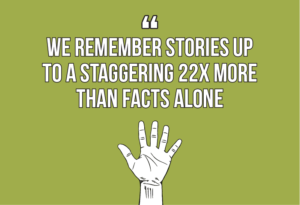 We’re sure you’ll know that a simple story can transform an ordinary message into something extraordinarily impactful and memorable.
We’re sure you’ll know that a simple story can transform an ordinary message into something extraordinarily impactful and memorable.
Research shows that we remember stories up to a staggering 22x more than straight-up facts – making them an invaluable tool in the internal comms practitioner’s utility belt.
The great news is, every message has the potential to be turned into a powerful, engaging story. You just have to pin down the essential elements, and arrange them in the most inspiring order.
Imagine you’re tasked with communicating a major business change, and you need to ensure 100% buy in.
To start piecing together the narrative, break the change journey down into its individual components within the framework of the typical story structure.
First, set the scene: What’s the change about?
Then move onto the conflict: why is the change necessary? What’s the reason behind it?
Next, explain the resolution: how the change will be unfolding, and how the organisation (and employees) will be better off for it.
This narrative of achieving success through adversity is inherently positive and incredibly inspiring, which is what makes it so relatable.
The clincher is that you vividly capture the WHY behind the change – providing a sense of purpose is a sure-fire way to rally people behind a cause.
Check out this awesome TED Talk from Simon Sinek, on why the WHY is so important when you want to inspire people to believe in your message (it’s one of our favourites!):
Here at H&H we love a good story. So when global technology giant Fujitsu asked us for help in increasing awareness around their Global Delivery Group amongst their employees, we jumped at the chance!
We extracted the essence of the GDG’s purpose and advantages and crafted a compelling and informative narrative that encapsulated key messages around how it could benefit the bottom line.

And it was a huge hit – with some great feedback from the delighted client:
“A sound approach, with wonderful images and words that resonate.”
However, if you’ve ever suffered from writer’s block, you’ll know how difficult it can sometimes be to come up with stories that will resonate and inspire – and above all, leave a lasting image in the reader’s mind.
Our Storytelling Cards are designed to help you bring your ideas and stories to life through the power of visual metaphors. They’re visually stunning, come with loads of thought-provoking designs, and can help you ignite your imagination when you’re drawing storytelling blanks.
We created our own visual story using the combination below – what ideas does it spring to your mind’s eye?

 Unleash the storyteller in you
Unleash the storyteller in you
Where will your imagination take you? Find out by grabbing your own pack of H&H Storytelling Cards
7. Talk with, not at, employees
This is perhaps the most important internal communications best practice advice we can give.
At heart, internal comms is all about conversation and dialogue. It should be open, honest, and inclusive – built on the foundations of bottom-up communication as well as top-down.
Intimate access to the employee voice is what makes an internal communicator so uniquely placed to add value within the workplace.
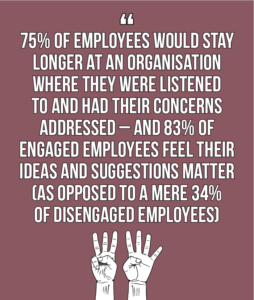
Research tells us that 75% of employees would stay longer at an organisation where they were listened to and had their concerns addressed, and 83% of engaged employees feel their ideas and suggestions matter (as opposed to a mere 34% of disengaged employees).
By acting as the spokespeople of employees and feeding their views, opinions and suggestions up the ladder to the C-Suite, internal comms professionals can help to cultivate a culture where everyone feels they have a say, regardless of seniority.
Leading to a more committed, engaged, and genuinely invested bottom line.
The crucial thing is that you make it as easy and accessible as possible for employees to get involved in the organisational conversation.
Create a workplace portal where they can deposit their thoughts, whether that’s in an online company forum or even in an ‘ideas and suggestions’ box (ours is pretty wacky – check it out below):

Champion individual employees’ stories to inspire colleagues or demonstrate how people are genuinely making an impact on the business.
And make yourself visible as a key point of contact for employees – so they know who to come to if they need any information.
One final tip: always keep these internal comms best practices at the front of your mind!
With all the wonderfully elaborate and exciting internal comms projects being delivered every day around the world, getting back to basics might seem like a needless simplification of the issues.
But that’s absolutely not the case.
Staying true to the principles of great IC is what drives the results that lead to more effective, engaged and productive organisations.
Keeping these internal communications best practices front-of-mind and sticking to them no matter the path a project takes – will ensure that IC greatness in the workplace always remains firmly in sight.
No internal comms challenge is too tough for us. Every day, we combine our unique creativity with a goldmine of strategic insights to deliver internal comms campaigns that delight our clients.
After all, it’s what we do best. So if you’re looking to create outstanding internal communications that will get your teams buzzing, or employee engagement/leadership development campaigns that will deliver the right results, we’d love to see how we could help you achieve your goals.
Got a brilliant idea you simply can’t keep to yourself?


 Got an awesome new business plan you can’t wait to tell your people about? We can help!
Got an awesome new business plan you can’t wait to tell your people about? We can help!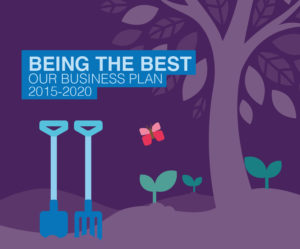 Creating shared understanding across the business
Creating shared understanding across the business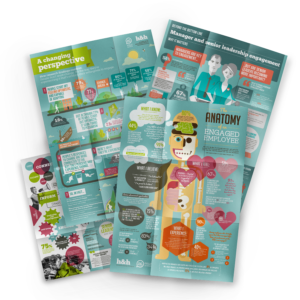 In internal comms, it pays to be informed
In internal comms, it pays to be informed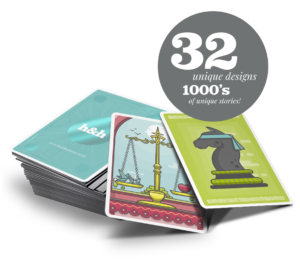 Unleash the storyteller in you
Unleash the storyteller in you









